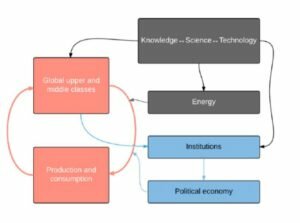 A couple of days ago there was a feisty exchange on Fox News between host Tucker Carlson and Bill Nye (“the Science Guy”). Carlson challenged Nye to establish that climatic changes are linked to anthropogenic greenhouse gas emissions, and quite frankly, Nye struggled to articulate a response.
A couple of days ago there was a feisty exchange on Fox News between host Tucker Carlson and Bill Nye (“the Science Guy”). Carlson challenged Nye to establish that climatic changes are linked to anthropogenic greenhouse gas emissions, and quite frankly, Nye struggled to articulate a response.
However, Mr. Nye, as well as instructors addressing this critical, and ever-abiding issue, might benefit from the results of a new study published in the journal The Anthropocene Review. What I found particularly salutary about this piece was its explanation of why the current bout of climatic change could be linked to different factors than factors than those that precipitated climate change in the past.
Among the conclusions of the study:
- During the period of the existence of the Earth’s biosphere, the primary drivers of earth system change have been two external force: astronomical (“forces that affect insolation and relate to solar irradiance include orbital eccentricity, obliquity and precession driven by gravitation effects of the sun and other planets”) and geophysical (forces that include “volcanic activity, weathering and tectonic movement”);
- In the past 2.588 billion years, climate forcing has been largely controlled by cyclical variation in Earth’s orbit and other astronomical forces, and irregular geophysical events, such as volcanic eruptions;
- Under current astronomical forcing and greenhouse gas concentrations in pre-industrial levels, we would have anticipated Holocene-like conditions for approximately another 50,000 years
- Internal dynamics, including biospheric evolutionary processes, can also drive the Earth System, however. Such factors are particularly important given their impacts on carbon dioxide, which exerts a substantial influence on climate.
- At this point, human activity (denominated as “H”), as a subset of internal processes, has reached a profound influence on earth system processes. Indeed, it has become the dominant driver of the rate of change of the Earth System. This has included a doubling of the amount of reactive nitrogen in the system relative to pre-industrial levels, and a huge change in ocean carbonate chemistry.
- In the context of climate change, atmospheric concentrations in recent years have increased 100x faster than the most rapid increases during last glacial termination. Methane levels have risen at a rate that is more than double the rates of the past 800,000 years. This has resulted in temperature increases 70x the baseline over the course of the past 100 years, and 170 the Holocene baseline rate over the course of the past 45 years
- Anthropogenic impacts crossed a critical threshold around 1950 during the “Great Acceleration” of greenhouse gas emissions, with human factors “usurping” the impacts of other factors “entirely.”
- Though it may come as cold comfort to humankind, while human factors may control earth systems over the course of the next tens of thousands of years, astronomical, geophysical and other internal factors are likely to ultimately re-assert control over the system.
It might be interesting to couple this reading for students with another recently published study seeking to assess the statistical likelihood that recent warming is primarily attributable to rising levels of anthropogenic emissions. This would be an excellent opportunity to tease out methodological considerations associated with so-called “climate attribution” studies.




